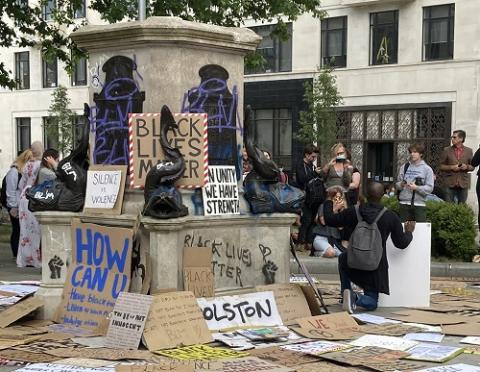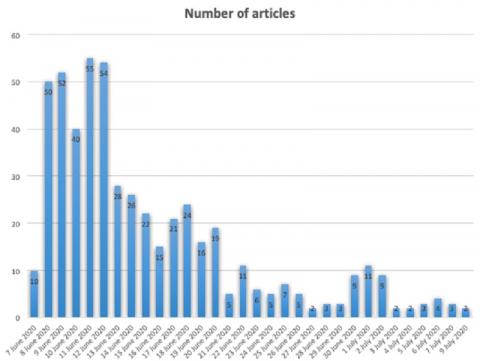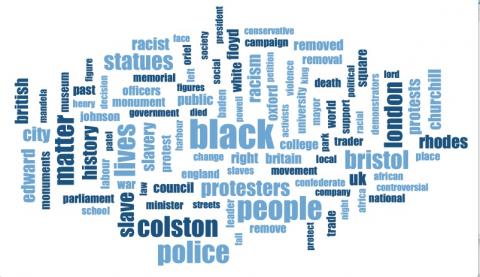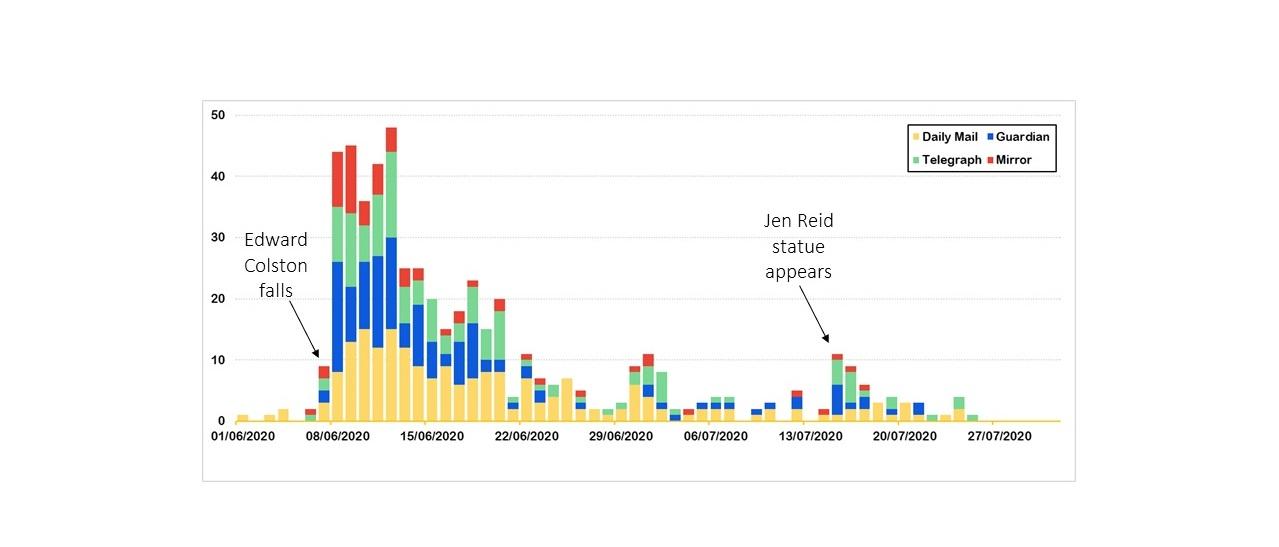Recording Decisions and Actions connected with Claims for the Removal/Protection of Statues
in UK Civic Spaces during the Summer of 2020
Demands to remove or amend monuments are nothing new. However, the current movement is unprecedented in its scale and level of public involvement. Previous discussions over the fate of statues in civic spaces tended to be localised, often confined to specialist committee meetings. The events of recent weeks, however, have seen the debate galvanise the nation as a whole, dominating newsfeeds and trending on social media platforms. In this process, a historicist urban topography is being rejected, and in its place bottom-up grassroots views on the usage and meanings of heritage are being formulated. Capturing this process will provide an invaluable archive through which we can better understand the role which heritage plays in social movements. Ultimately this understanding will offer us the potential to develop policies which align heritage more closely with our collective well-being.
An Open Access Repository of data collected during the project is now available to access and download.
The database has been created in the belief that by capturing as much of the debate as possible we could produce a valuable archive for future researchers, policy makers, heritage professionals and activists. If you download and use this data we would love to hear from and about how this record is being used. Contact us on heritage@arch.cam.ac.uk

The empty pedestal of the statue of Edward Colston in Bristol by Caitlin Hobbs / CC-BY 3.0
Project Overview
In response, the Cambridge Heritage Research Centre (CHRC) is conducting a six-week recording project. We will focus on two dimensions of the on-going debate: i) the public debate and public actions, as well as the role of advocacy groups; and ii) how core institutions are formulating their responses. We aim to record how the rhetoric develops (if it does), what factors affect the rhetoric (i.e. is it responding to critique from grassroots movements, from politicians or from various spokespersons), and how different statues are drawn into the claims (who instigates this and why). The core institutions interviewed will be grouped into national institutions, museums with collections or roles that pertain to the history of slavery, and civic organisations.
Project Update - Monday 13 July 2020
Over the past two weeks we've been focusing on gathering a complete record of the statue debate in four mainstream newspapers – The Guardian, The Telegraph, The Daily Mail and The Mirror. Since the fall of the statue of Edward Colston in Bristol, these papers have published more than 480 articles, totalling nearly 600,000 words. The Daily Mail has been the most vocal, publishing more than 180 articles! This record provides a great insight into the kinds of narrative which people encounter about taking down statues; a quick look at the most common words used already starts to reveal some interesting trends.

We are also starting to get in touch with institutions and organisations for the second half of the project: recording their responses to recent events. Obviously, we won’t have time to contact everyone who is making these kind of decisions, so we’re focusing on a selection of interesting ‘case studies’ from across Britain which have been appearing in the newspaper articles, and which seem representative of the wider situation. If you have any interesting leads, or if you see a great article outside of the four papers we’re focusing on, please feel free to get in touch!

Project Update - Monday 27 July 2020
Over the last couple of weeks, the media debate about statues in the UK has slowly started to quieten down. After the initial excitement, it seems that the newspapers have largely moved on to other things. Even the controversial arrival of the statue of Jen Reid in on the plinth vacated by Colston in Bristol couldn’t reignite the debate much (see image).
Outside of the media, though, the debate is only just getting started, and we’ve been talking to various people to get their take. So far, we've spoken to museums in London, local government in Bristol and the campaigning organisation Countering Colston (https://counteringcolston.wordpress.com). This week and next week, we'll be speaking to institutions and organisations in Oxford and Edinburgh as well as the National Trust and Historic England. The people we've interviewed have given us detailed and carefully thought through answers. They've also often been admirably frank in their reflections on the issues which have been brought to the fore by the Black Lives Matter Movement and the pulling down of Edward Colston's statue. We're certainly grateful to those who've taken the time to engage with our research and we're looking forward to the conversations which have yet to come!

Project Update - Tuesday 1 September 2020
We are coming to the end of the project with only a couple more weeks to go. For the past month we've been mainly concentrating on interviews, and so far we've transcribed nearly 35,000 words from these. Each interview transcription will go on our open access archive once the project is completed. The people we've interviewed tend to be speaking on behalf of their institution or organisation, but we have also spoken to people who have become involved in the debate in their capacity as individual activists. We've looked across the country for people to interview, but we've also focused on three case studies: the commemoration of Edward Colston in Bristol, the removal of the statue of Robert Milligan in London and the proposed plaque to accompany the Melville Monument in Edinburgh. Across the board the variety of insights offered by our interviewees has been really enlightening and we'd like to thank them again for taking the time to speak to us.
Project Results
The data collected throughout this project has been made available open access through the Cambridge Heritage Research Centre website here. A second phase of the project hopes to make these records available more permanently in an institutional open access repository and to provide visualisations to help researchers, policy makers, heritage professionals and activists view, retrieve and use this data.
The database has been created in the belief that by capturing as much of the debate as possible we could produce a valuable archive that has the potential to inform better decision making in future.
The database includes data gathered over a period of three months from June to September 2020. The database contains 13 interviews with key individuals involved in the debates over the future of contested statues, over 300,000 social media responses from YouTube, Reddit and Twitter, and record of the debate in four mainstream newspapers over the period of the project. If you download and use this data we would love to hear from and about how this record is being used. Contact us on heritage@arch.cam.ac.uk to let us know about your work.
Project Team
Project Leaders: Prof Marie Louise Stig Soresnen, Dr Dacia Viejo Rose and Dr Liliana Janik
Project Research Assistants: Dr Mark Haughton, Tom Crowley and Andrea Kocsis
Project Administrator: Ben Davenport
Funding
The Cambridge Heritage Research Centre is grateful to the Arts & Humanities Impact Fund, Vice-Chancellor Office and the McDonald Institute for Archaeological Research for the generous support that has made this project possible.
